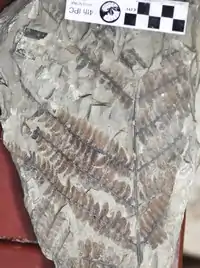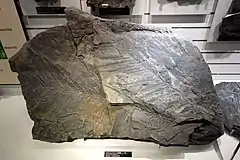Cladophlebis
Cladophlebis is an extinct form genus of fern, used to refer to Paleozoic and Mesozoic fern leaves that have "fern fronds with pinnules that are attached to the rachis, and have a median vein that runs to the apex of the pinnule, and veins from that are curved and dichotomise". By convention this genus is not used to refer to fossil ferns from the Cenozoic. Ferns with this morphology belong to several families, including Osmundaceae, Dicksoniaceae and Schizaeaceae.[1] Ferns with this morphology are common during the Paleozoic and Mesozoic in both the northern and southern hemispheres.[2]

| Cladophlebis | |
|---|---|
 | |
| Cladophlebis nebbensis | |
| Scientific classification | |
| Kingdom: | |
| Class: | |
| Order: | |
| Genus: | Cladophlebis Brongniart 1849 |
| Species | |
|
See text | |
Species
There were many species of Cladophlebis, including: C. akhtashensis, C. arctica, C. browniana, C. denticulata, C. dunberi, C. haiburnensis, C. heterophylla, C. hirta, C. impressa, C. kurtzi, C. lobifolia, C. nebbensis, C. patagonica, C. phlebopteris, C. porsildi, C. readi, C. remota, C. retallackii, C. roessertii, C. septentrionalis, C. simplicima, C. spectabilis, C. tenuis, C. wyomingensis, and C. yanschinii.
Distribution
Fossils of Cladophlebis have been found in many locations around the world, among others in the Valle Alto Formation of Caldas and the Caballos Formation of Tolima, Colombia,[4] and the Winton Formation, Eromanga Basin, Queensland, Australia.[5]
References
- "Cladophlebis – New Zealand's Mesozoic Weed". Mike Pole. 2014-06-22. Retrieved 2020-11-24.
- Cladophlebis at Fossilworks.org
- Holmes, W. B. Keith (2001). "The Middle Triassic megafossil flora of the Basin Creek Formation, Nymboida Coal Measures, New South Wales, Australia. Part 2. Filicophyta". Proceedings of the Linnean Society of New South Wales. 123: 39–87.
- Monje-Dussán et al. 2016, p. 38.
- McLoughlin, Drinnan & Rozefelds 1995.
Bibliography
- McLoughlin, S.; Drinnan, A. N.; Rozefelds, A. C. (1995). "A Cenomanian flora from the Winton Formation, Eromanga Basin, Queensland, Australia". Memoirs of the Queensland Museum. 38 (1): 273–313. NAID 10004671569.
- Monje-Dussán, Camila; Martínez, Camila; Escapa, Ignacio; Madriñán, Santiago (1 June 2016). "Nuevos registros de helechos y coníferas del Cretácico Inferior en la cuenca del Valle Superior del Magdalena, Colombia" [New records of ferns and conifers from the lower Cretaceous in the Upper Magdalena Valley Basin, Colombia]. Revista Boletín de Geología (in Spanish). 38 (4): 29–42. doi:10.18273/revbol.v38n4-2016002. Gale A499494271.
External links
- Zimmermann, Walter (1969). "About Mesozoic Pteridophylls". American Journal of Botany. 56 (7): 814–819. doi:10.2307/2440603. JSTOR 2440603.
- Cladophlebis austalis Natural History Museum
- Range map for Cladophlebis from the PaleoBiology Database